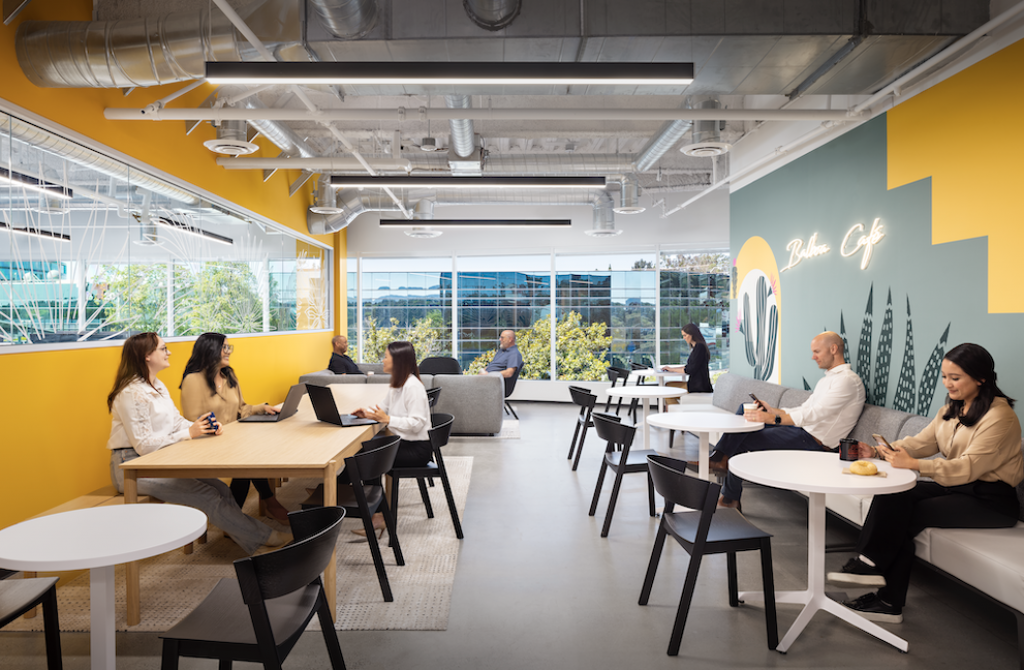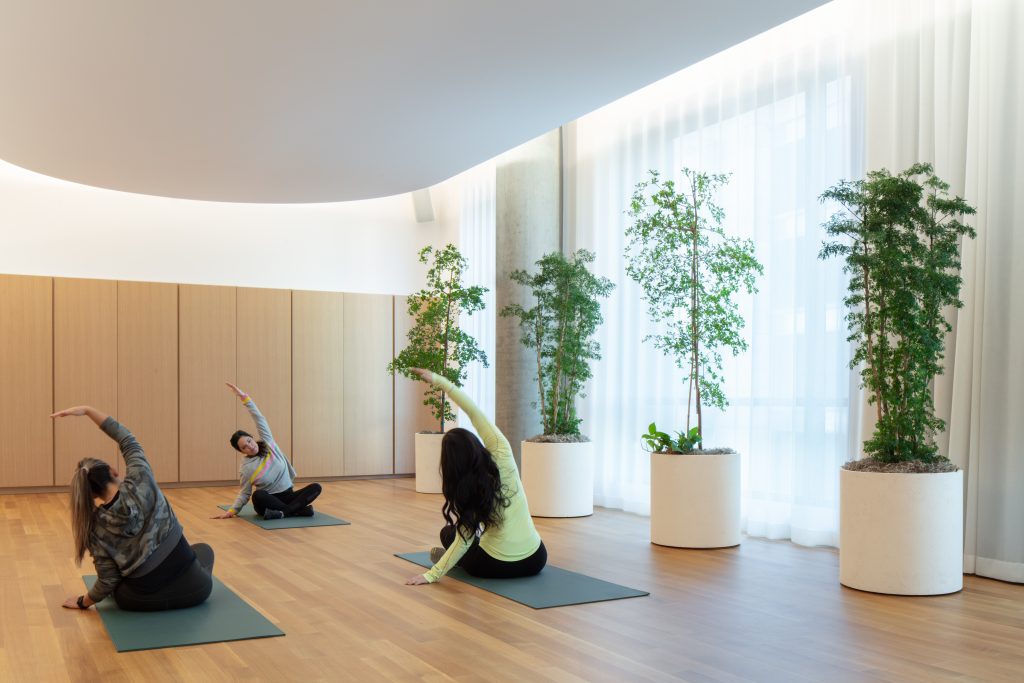The HGA design team shares their internal approach and best practices for driving environmental and cultural change.
As workplace designers we are “agents of impact”—curators of space and corporate culture that have influence well beyond the office building itself. Understanding our role and best practices in this transformational time of collective action amidst a climate crisis are not only key to our success as designers, but also our responsibility as global citizens with the unique power to drive change.
The latest ThinkLab data suggests,
architects and designers have 40 times the specification purchasing power as the average American consumer as a result of the scale of our work.
In the top 200 A&D firms in the country, that number can be as high as 140 times. It’s critical that we acknowledge how the decisions we make now have increasingly immense power to affect the future health of our environment.
Similarly, the companies we work with have a unique opportunity to set and pursue Environmental, Social and Governance (ESG) goals in meaningful ways through their physical spaces as well as the cultural climates fostered within them, and experienced designers can give them the platform to walk their talk. When thoughtful ESG goals are backed by tangible action, employees are, on average, more engaged at work and more aligned with their company’s mission and purpose—ultimately leading to improved business performance.
A recent study by the NYU Stern Center for Sustainable Business concluded that ESG disclosure on its own does not drive financial performance but, over a long-term horizon, a deliberate integration of sustainability strategies is positively correlated to a healthy bottom line as they spur innovation, raise operational efficiency and improve risk management.
Bringing ESG Goals To Life, Starting With Decarbonization
Over the last decade, there has been a sea change in terms of awareness and engagement by the general public with regard to sustainability efforts. Decarbonization remains a key goal for many organizations and is often a priority for building projects. However, many companies report ESG goals that only include operational carbon; embodied carbon is a forgotten, yet essential, piece of the puzzle. Focusing on embodied carbon is proven to significantly amplify overall carbon goals and position organizations to realize a more holistic view of their impact.
As interior designers working within an interdisciplinary design firm, we are on the forefront of tracking embodied carbon and researching ways to reduce negative environmental impact. Embodied carbon is directly linked to climate change, and interior renovations and tenant improvements are some of the biggest contributors to carbon in our atmosphere due to the frequency of renovation work done over a building’s life cycle. Any material we select increases the building’s carbon footprint, so any design solution that intentionally reduces the number of materials used (or selects materials that can be easily disassembled for future reuse) has a huge impact across our projects, and this should encourage us to rethink the typical approach to workplace design. This presents an immense opportunity for interior designers to play a role in climate action.
As agents of change, designers can leverage data outlined in Environmental Product Declarations (EPDs) to prioritize carbon reduction and make better decisions that are both aesthetically pleasing and environmentally responsible. This should foster a renewed perspective on success, looking beyond the surface into the deeper story a designed environment is telling of climate health and employee wellness. A product’s content, where it comes from, how it’s installed and maintained, how long it lasts and where it goes at the end of its useful life all factor into its carbon footprint and the decision-making process.
To hold ourselves accountable, HGA’s Embodied Carbon Resource Guide includes “The Embodied 8”—eight principles that are authentic to our values and serve as a starting point for greatly reducing the embodied carbon impact on our projects, detailed in-depth in HGA’s 2024 Sustainability Action Plan:
- Keep in Mind, Less is Less
- Discuss Access & Impact
- Choose Your Site Wisely
- Build for the Long Term
- Optimize Building Shape, Size & Envelope
- Understand Structural Options Early
- Solidify Material Selection Strategies & Goals Early
- Remember, HGA’s Standards Are Our Baseline & Are Ever-Evolving
We have a professional responsibility to select low carbon and carbon sequestering materials, as well as consider the impact of all the elements of our work processes. This translates to direct benefits to the organizations we design for including offering better data, supporting authentic goal alignment, saving money through reused materials and comparably priced sustainable materials and leaning project schedules through local sourcing. This decarbonization work has the added benefit of supporting official building certifications, such as LEED or the Living Building Challenge—further showcasing an organization’s commitment to sustainability to their employees, clients and partners.
Beyond Decarbonization
It’s easy for ESG conversations to focus on merely carbon goals, but there are many more pieces to the puzzle, such as a well-rounded review of climate data and understanding of how it impacts human health. For example, the current rising temperatures globally contribute to rising indoor heat temperatures that lead to poor employee health impacts such as cognitive decline and poor performance. With rising outdoor temperatures and wider temperature swings, indoor air quality is becoming increasingly harder to manage. Recent research shows materials are off-gassing at extreme rates, even materials that have VOCs rated within acceptable limits when tested at normal temperatures. This might mean that indoor air quality becomes unhealthy for the users during a heat wave, especially if the cooling system is struggling to keep up, or if the building has experienced a power outage.
These effects are compounded by the fact that the industry standard is to use historical weather data as a basis for design. We are often still looking at 30-year-old data to make crucial decisions for buildings and spaces that will last decades into the future and in a shifting climate. Even thermal data—i.e. the ideal indoor temperature for men versus women—is outdated, yet still informs workplace design. HGA’s Climate Forward report details this dilemma and provides specific recommendations for climate data developers and boundary organizations, AEC associations and professionals, policy makers, building code and standards bodies, higher education institutions and any organization that hires AEC professionals. With the proper action and increased collaboration from all parties, we can close the gap between the latest climate science and the AEC industry to build a more resilient future.

Building Culture Through Healthy Design
Beyond physical health, companies can nudge and nurture their workplace culture through spaces that support their people and behaviors that align with their greater organizational purpose. According to recent Gallup data, only two in 10 U.S. workers feel connected to their organization’s culture. This is a prime opportunity for interior designers to fold in their expertise in human-centered, empathetic design, to create spaces that authentically build community through gathering and engagement in support of social and emotional well-being, which is crucial for holistic employee wellness.
Connection to nature can be a key strategy in this regard. Research shows that visual connections to nature—such as natural plantings, daylighting and natural wood grains—can reduce stress, amplify emotional functioning, improve concentration, bolster resilience, enhance overall happiness and much more. These design elements are also helpful tie-ins to a company’s ESG story, as they provide a clear cognitive connection from the workplace to the planet at-large.

Another contributor to employee well-being is social connection—connection to colleagues and the organization. This connectivity can be fostered through formal and informal gathering areas for both respite and active collaboration. Spaces for socialization can provide an avenue for employees across generations and departments to gather and get to know each other, building bonds that create an overall workplace culture. Open spaces throughout the office can provide inviting and intuitive areas for groups to gather, leading to natural knowledge sharing, mentorship and creation of healthy cultural norms.
Every organization is unique and requires an understanding of their culture to develop representative strategies and curate their ESG story; it’s important as designers to loop in a diverse cohort of stakeholders during the design process so that users can see themselves and their culture reflected in the final product. The balance between people and operations is crucial, and often the best design isn’t trendy, but rather resilient, inclusive and long-lasting.
The opportunity is clear, yet the path ahead is challenging. Meaningful change requires collective action through holistic design thinking. This is a global effort—with global urgency. Once we understand our responsibility and the path forward, we can partner with other specialties and fabricators to make a difference. We also must be vigilant in continuous dialogue with colleagues and clients to design more sustainable spaces with products that consider the overall impact on both climate and human health.

